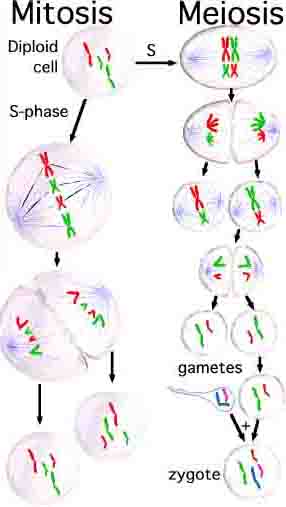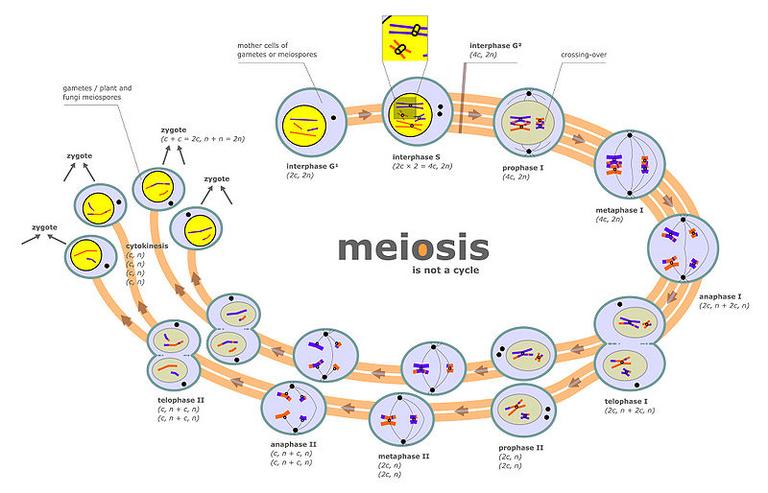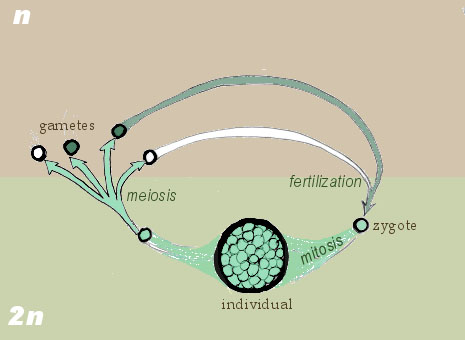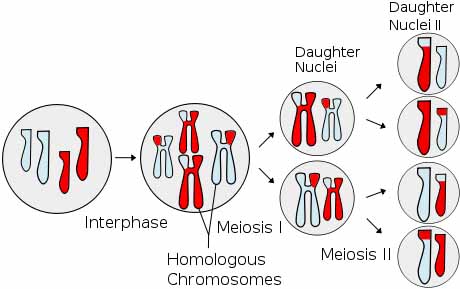 | ||||
Types of Cell Division: Meiosis - P3
SPO VIRTUAL CLASSROOMS
Sources and Helpful Links on Cell Division
- Campbell, N. A. & Reece J. B. (2005) Biology, seventh edition. Pearson Education Inc.
- Campbell, N. A., Reece J. B. & Simon, E. (2004) Essential Biology with Physiology. Pearson Education Inc.
- DNA Replication step-through animation by John Kyrk
- DNA Replication animation and quiz from Essential Biochemistry
- How the Cell Cycle Works, animation & quiz from McGraw-Hill.
- Mitosis & Cytokinesis, animation & quiz from McGraw-Hill.
- Mitosis animation, step-through and quiz, Sadava, et al., Life: The Science of Biology, 9th Edition, Sinauer Associates.
- Mitosis step through animation from CellsAlive.com.
NEW! FREE Educational Materials on Cell Division
- Meiosis Homework Assignment (or Word .doc)
PAGE 3 < Back to Page 2
You have free access to a large collection of materials used in a college-level introductory Cell Biology Course. The Virtual Cell Biology Classroom provides a wide range of free educational resources including Power Point Lectures, Study Guides, Review Questions and Practice Test Questions.
Page last updated: 3/2016
 | ||||
What is Meiosis?
Meiosis is the type of cell division that produces gametes, sperm or eggs, in sexually reproducing organisms. Meiosis reduces the number of chromosome by half, so that when a sperm fertilizes an egg, the resulting zygote has a full set of chromosomes.
Ploidy: Diploid & Haploid
Most of the cells in your body are somatic cells that have a diploid (2n) chromosome number, for humans that's a total of 46 chromosomes.
During meiosis there are two cell divisions of a diploid (2n) germ cell, resulting in four haploid (n) gametes.
Meiosis I & II
As is the case in mitosis, in meiosis the cell duplicates its chromosome number prior to beginning cellular division (a process called replication). Then nuclear division, the sorting out of the genetic material, begins and unfolds over the course of 2 cellular divisions (meiosis I and meiosis II), resulting in 4 gametes.
Meiosis I
During meiosis I, pairs of chromosomes buddy up at the cell’s equator and then each moves to opposite ends of the cell. What started with one cell, now consists of two cells that each have a 23 duplicated chromosomes.
Meiosis I results in two cells that now have half the number of chromosomes, but those chromosomes are still duplicated. The role of meiosis II is to separate the duplicated chromosomes, resulting in four sex cells (gametes) with half the number of chromosomes (unduplicated) as the parent cell.
Since meiosis produces haploid gametes, you received a set of 23 chromosomes from your mother’s egg and a matching set of 23 from your father's sperm.
WHICH GENETIC TRAITS DO YOU HAVE?
Meiosis II
Meiosis II unfolds much like mitosis does, but without the chromosomes replicating before nuclear division. Each duplicated chromosome left over from meiosis I lines up at the two cells' equators and these sister chromatids (as the duplicates are called) separate and move to opposite poles. Meiosis II ultimately results in 4 cells that, in humans, each have 23 (1n) chromosomes.
Fun Video on Meiosis from
Crash Course Biology
You have free access to a large collection of materials used in a college-level introductory microbiology course. The Virtual Microbiology Classroom provides a wide range of free educational resources including PowerPoint Lectures, Study Guides, Review Questions and Practice Test Questions.








